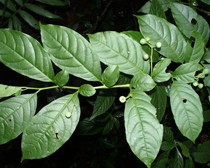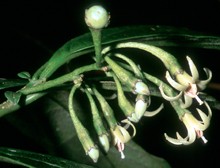|
 |
 |
|
habit with fruit |
flower |
Witheringia cuneata (Standl.) Hunz.Solanaceae - Eggplant Family |
|
|||||
|
|||||
|
Description. Treelet, 3-6 m; twigs round, nodes swollen, fine dorsal ridge arising between petioles; leaves often paired, petioles to 15 mm, blades to 5 x 19 cm, narrowly elliptic, asymmetric, glabrous above, soft erect hairs below on blade and veins, evident to touch, minor leaf to 3 x 11 cm, narrowly elliptic to ovate, spicey bean odor in leaf; inflorescence with peduncle 2-5 cm, erect, arising between leaf pairs, with groups of flowers that open successively; flower with pedicel 6-10 mm, calyx 6-7 mm, forming a tube, lobes 1.5 mm, glabrous, corolla 15 mm long, pale green, each lobe with a supapical tooth outside, style 10 mm, stamens tan, filaments pubescent, ovary glabrous; fruit to 13 x 15 mm, subglobose, green-white immature, blue mature, with pedicel 10-12 mm. Similar species. Cuatresia riparia- a treelet with similar leaf arrangement, but glabrous and the flowers are essentially sessile; more abundant than W. cuneata. C. exiguiflora- a similar leaf conformation, but the leaves are generally much broader and glabrous; rarely seen in flower or fruit. Local distribution. Pacific slope at 1400-1600 m in premontane wet forest and leeward cloud forest. Habitat. Open understory, gaps and forest edge in cloud forest; restricted to wetter sites in premontane zone. Species range. Nicaragua to Venezuela. Abundance. Common Phenology. Flower: may; Fruit: jun.
Herbivores. Ithomia xenos (Ithomiinae) Pollinators. Bees Seed dispersers. Birds and possibly bats Comments. A locally patchy treelet of open understory, gaps and forest edge in cloud forest; restricted to wetter sites in the premontane zone. Voucher No. Haber 11480 |
|